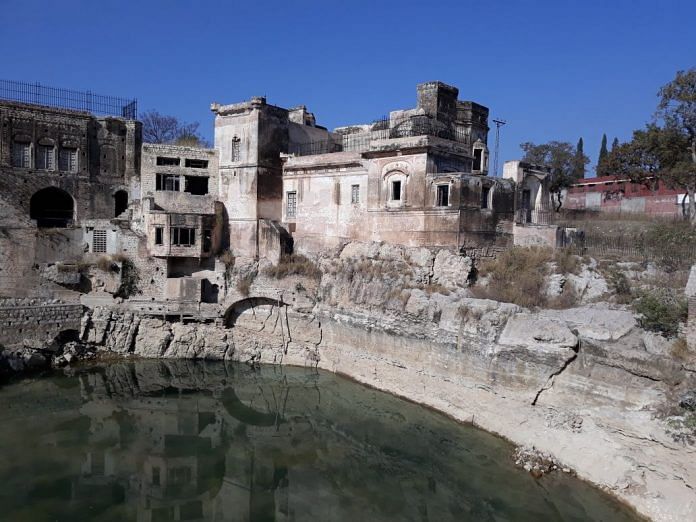The pond around the 6th century Katas Raj temple in Pakistan is now slowly drying up because of cement factories and illegal tube wells.
Chakwal, Punjab, Pakistan: It is said that when Lord Shiva gathered his beloved wife Sati’s lifeless body in his arms and began roaming the earth to find an isolated place to grieve, two of his tears fell on the ground and formed a little body of emerald green water in Pakistan.
In the 6th century, the Katas Raj temple was built around this pond, in what is today the Chakwal district of Pakistan. Since then, Hindu pilgrims have travelled here to bathe and wash away their sins.
The pond, a testament to Shiva’s unfailing love, is now slowly being lost. Large cement factories moved into the area ten years ago, and began sucking out more and more ground water. Officials say the groundwater in the pond has plunged from 22 feet to three feet.
Alarmed by media reports, the Supreme Court of Pakistan took suo motu cognisance of the matter in November. At one hearing, the Chief Justice chided state departments for neglecting the 3,000-year-old site.
“The temple is not just a place of cultural significance for the Hindu community, but also a part of our national heritage,” Justice Mian Saqib Nisar said. “I want a solution to this problem.”
Pulling double the water allowed
The Katas Raj complex houses seven ancient structures. It is the most revered of the 13 functioning Hindu temples in Pakistan.
Off the six-lane motorway that runs between Lahore and Islamabad, the temple complex is nestled in a corner of Choha Saidan Shah, a small town with an estimated population of 30,000 people. There is only one Hindu family here.
Six cement factories set up manufacturing units in this quiet and undisturbed town. Bestway Cement, owned by the London-based businessman Sir Anwer Pervez, lies within five kilometres of the complex, while DG Khan Cement, owned by Mian Muhammad Mansha, Pakistan’s first billionaire, is just over 10 kilometres away from the Katas Raj complex. There is no other source of water here, and factories and residents are forced to dig deep wells to draw out water, or rely on seasonal rainfall.
“Both Bestway and DG Khan employ 4,000 people,” Zaheer Anwar, the Assistant Commissioner of the area, told ThePrint. “Due to the water situation, these companies are allowed to use only 140 cubic metres of water per day.”
But the Supreme Court was informed last week that each is consuming over 300 cubic metres of ground water daily, almost double the permitted limit.
Officials downplay the problem
The government of the state of Punjab underplays the environmental damage caused by the industries, and points to other factors too.
“The population has grown from a few thousand people to almost 30,000 here,” said a senior official of the Evacuee Trust Property Board, who asked not to be named. “Then there is climate change. This year, the district has received less rainfall than normal. Once it rains, the pond will fill up by itself.”
But that is unlikely to solve the problem. The pond was in danger of drying up in 2012 as well, after which three water pumping stations nearby were closed. This time, the court is not afraid to take more drastic measures to save the pond.
Justice Nisar remarked in a hearing that if the environment is adversely affected, then all the factories will be shut down, according to a media report. In its latest hearing, on 13 December, the court has ordered Bestway Cement to refill the pond within one week.
As court proceedings continue, other concerns have also come to light. Judges have repeatedly asked authorities to explain the mysterious disappearance of the statues of Lord Ram and Hanuman from the temple.
“There was a lot of damage after the Babri Masjid incident in India,” said the board official. “But we have ordered new statues of the deities from India that should be arriving soon. We have been doing a lot of good work as well that the media does not highlight,” referring to the Rs 10 million (Pakistani currency) renovation project for the complex inaugurated by former Prime Minister Nawaz Sharif in January.
“This the first time the monument is undergoing restoration, no such work has ever been initiated before,” said Abdul Qadeer Khan, the secretary of the board.
Since then, new walkways have been built to connect the temples, cages set up and filled with birds and monkeys. Also, 36 guest rooms are under construction for the 400 pilgrims who arrive from India each year. Domestic tourism has also gone up since the project was undertaken, with an estimated 10,000 visitors to Katas Raj this year.
But even if the temple is saved from ruin, and the monuments restored and rebuilt, what would become of Shiva’s emerald green tears?
“The cement factories will need to be regulated, without hesitation,” Khan added. “The illegal tube wells will have to be shut down. But I don’t know what the court will decide.”
Benazir Shah is the features editor for Geo.tv



